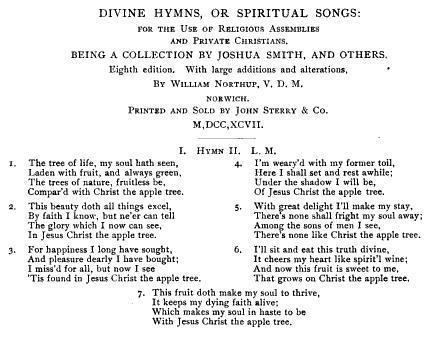 | ||
Jesus Christ the Apple Tree (also known as Apple Tree and, in its early publications, as Christ Compared to an Apple-tree) is a poem, presumably intended for use as a carol, written by an unknown person in the 18th century. It has been set to music by a number of composers, including Jeremiah Ingalls (1764–1838) and Elizabeth Poston (1905–1987).
The first known publication of "Jesus Christ the Apple Tree" was in London's Spiritual Magazine in August, 1761. This credits "R.H." as the submitter and presumed author. Another early printing, which cannot be dated closely but may well be the second and could even be earlier, is an English broadsheet. This broadsheet uses the term "Methodists," which certainly places it after about 1730, when the term first came into use at Oxford University, and probably substantially later, when the religious movement had spread.
The hymn's first known appearance in a hymnal, and in America, was in 1784 in Divine Hymns, or Spiritual Songs: for the use of Religious Assemblies and Private Christians compiled by Joshua Smith, a lay Baptist minister from New Hampshire. It became quite common in American hymnbooks, though not in English ones, after that, and for that reason has often been assumed to have an American author; there is no evidence however to support this.
The song may be an allusion to both the apple tree in Song of Solomon 2:3 which has been interpreted as a metaphor representing Christ, and to Jesus' description of his life as a tree of life in Luke 13:18–19 and elsewhere in the New Testament including Revelation 22:1–2 and within the Old Testament in Genesis. Apple trees were commonly grown in early New England and there was an old English tradition of wassailing or wishing health to apple trees on Christmas Eve. The song is now performed by choirs around the world, especially during the Christmas season as a Christmas carol.
Another motivation of the song may have been to Christianize old English winter season songs used in wassailing the apple orchards — pouring out libations or engaging in similar ceremonies to seek fertility of the trees.
